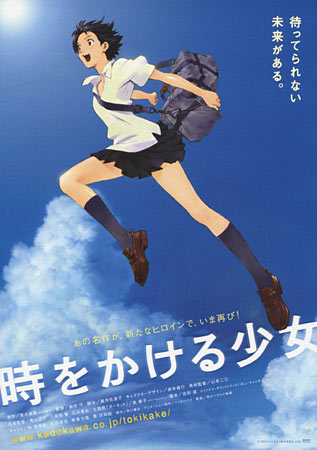
Image: Wikimedia.
I had planned to write an unbiased review of Mamoru Hosoda’s The Girl Who Leapt Through Time, but that proved to be impossible, for a number of reasons.
The evening before I made the trip to Roppongi for the Tokyo International Film Festival, I was sitting on the floor of my room, trying to respond to an essay prompt from a film school graduate program.
“What kind of stories do you want to tell?”
I was stuck. I wrote about the camera I use, things I know about teamwork, and everything about film production but stories. What kind of films do I want to make? How could I know?
The next day, I made my way to Toho Cinemas and found my assigned seat before the lights went down in the theater. Mamoru Hosoda’s 2006 film began to play.
The Girl Who Leapt Through Time is about a high school girl. Her life is ordinary. You could call it mundane, but her life is a story in itself. It’s told very carefully, marking the important moments in her school year when she struggles trying to make things easier on herself but, in the process, hurting her friends and family. She experiences something extraordinary in realizing she has the ability to time travel, but this miracle is not the focus of the film. How could time travel be the main thing in her life, when she is struggling with what it means to build good relationships, make choices for the future, and be herself, but not be selfish?
Sitting in the theater, it hit me. This is the kind of story I want to tell.

Image: tumblr.
The image I’ve always had in my head of a “filmmaker” is a dramatic auteur, spinning dark, traumatizing tales that leave the viewer shaken yet applauding at the end. But when I sit down to write, or even edit, this kind of dramatic flair doesn’t make itself known. What does appear is something careful, or simple. Something to do with finding joy in the mundane.
In the documentary The Kingdom of Dreams and Madness, another master of animation, Hayao Miyazaki, mentions that he likes to collect ordinary moments from life. He flips through a photo album filled with images of a small town and its inhabitants, filled to the brim with notes and diary entries.
In the behind-the-scenes of his most well-known film, Spirited Away, Miyazaki is seen explaining to Studio Ghibli animators how to convey fantastical things in the film based on what he has observed in everyday life:
“The dragon falls from the wall like a snake falling out of a tree,” he says.
“The river spirit is filled with junk and even a bicycle, like the river near where I grew up.”
Miyazaki’s films are often placed in an extraordinary, magical world, but the stories and characters are grounded in the ordinary.
Similarly, The Girl Who Leapt Through Time features a character who, despite going through something unusual, is living her life in the same ordinary way as any other person who has to grow up. She is learning for the first time what it means to make important choices and hold other people’s feelings as important as her own.
Instead of using time travel to dramatically convey every aspect of the protagonist’s growth, the small moments in her life tell the real story: she wishes her sister hadn’t eaten her pudding, she plays baseball with her best friends, and she tries to avoid making decisions that would change her entire life. As Mamoru Hosoda said at TIFF, what people relate to in the story is not that it’s about time travel, or that it’s about a Japanese high school girl. It’s a film about regret.
Hosoda also noted that human beings don’t always realize until later how important the ordinary, everyday moments and everyday people that make up our lives are. The mundane, the unextraordinary (even in extraordinary circumstances) is what makes us ourselves.
I want to tell stories like this: thoughtful, careful stories. I know, already, that I tend to do so. It just didn’t hit me until this moment.
I cried through the entire film. And, judging by some of the audience’s reactions during the Q&A, I was not the only one.